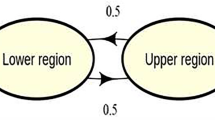Abstract.
Many of the existing models on stage structured populations are single species models or models which assume a constant resource supply. In reality, growth is a combined result of birth and death processes, both of which are closely linked to the resource supply which is dynamic in nature. From this basic standpoint, we formulate a general and robust predator-prey model with stage structure with constant maturation time delay (through-stage time delay) and perform a systematic mathematical and computational study. Our work indicates that if the juvenile death rate (through-stage death rate) is nonzero, then for small and large values of maturation time delays, the population dynamics takes the simple form of a globally attractive steady state. Our linear stability work shows that if the resource is dynamic, as in nature, there is a window in maturation time delay parameter that generates sustainable oscillatory dynamics.
Similar content being viewed by others
References
Aiello, W.G., Freedman, H.I.: A time-delay model of single species growth with stage structure. Math. Biosci. 101, 139–153 (1990)
Aiello, W.G., Freedman, H.I., Wu, J.: A model of stage structured population growth with density dependent time delay. SIAM J. Appl. Math. 52, 855–869 (1992)
Arino, O., Sánchez, E., Fathallah, A.: State-dependent delay differential equations in population dynamics: modeling and analysis. Topics in functional differential and difference equations (Lisbon, 1999), Fields Inst. Commun., 29, Amer. Math. Soc., Providence, RI, 2001, pp. 19–36
Beretta, E., Kuang, Y.: Geometric stability switch criteria in delay differential systems with delay dependent parameters. SIAM. J. Math. Anal. 33, 1144–1165 (2002)
Cooke, K.L., van den Driessche, P., Zou, X.: Interaction of maturation delay and nonlinear birth in population and epidemic models. J. Math. Biol. 39, 332–352 (1999)
Ginzburg, L.R.: Evolutionary consequences of basic growth equations. Trends Ecol. Evol. 7, 133–133 (1992)
Gourley, S.A., Kuang, Y.: Wavefronts and global stability in a time-delayed population model with stage structure. Proc. Roy. Soc. Lond., Ser. A. 459, 1563–1579 (2003)
Gurney, W.S.C., Nisbet, R.M.: Fluctuation periodicity, generation separation, and the expression of larval competition. Theoret. Population Biol. 28, 150–180 (1985)
Gurney, W.S.C., Nisbet, R.M., Blythe, S.P.: The systematic formulation of models of stage-structured populations. The dynamics of physiologically structured populations (Amsterdam, 1983), Lecture Notes in Biomath., 68, Springer, Berlin, 1986, pp. 474–494
Hainzl, J.: Stability and Hopf bifurcation in a predator-prey system with several parameters. SIAM J. Appl. Math. 48, 170–190 (1988)
Hainzl, J.: Multiparameter bifurcation of a predator-prey system. SIAM J. Math. Anal. 23, 150–180 (1992)
Jones, A.E., Nisbet, R.M., Gurney, W.S.C., Blythe, S.P.: Period to delay ratio near stability boundaries for systems with delayed feedback. J. Math. Anal. Appl. 135, 354–368 (1988)
Kuang, Y.: Global stability of Gause-type predator-prey systems. J. Math. Biol. 28, 463–474 (1990)
Kuang, Y.: Delay differential equations with applications in population dynamics. New York: Academic Press, 1993
Kuang, Y., Fagan, W., Loladze, I.: Biodiversity, habitat area, resource growth rate and interference competition. Bull. Math. Biol. 65, 497–518 (2003)
May, R.M.: Stability and Complexity in Model Ecosystems (Princeton Landmarks in Biology). Princeton: Princeton University Press, 2001
Murdoch, W.W., Briggs, C.J., Nisbet, R.M.: Consumer-Resource Dynamics. Princeton: Princeton University Press, 2003
Nisbet, R.M., Gurney, W.S.C.: ‘‘Stage-structure’’ models of uniform larval competition. Mathematical ecology (Trieste, 1982), Lecture Notes in Biomath. 54, Springer, Berlin, 1984, pp. 97–113
Nisbet, R.M., Blythe, S.P., Gurney, W.S.C., Metz, J.A.J.: Stage-structure models of populations with distinct growth and development processes. IMA J. Math. Appl. Med. Biol. 2, 57–68 (1985)
Nisbet, R.M., Gurney, W.S.C., Metz, J.A.J.: Stage structure models applied in evolutionary ecology, Applied mathematical ecology (Trieste, 1986), Biomathematics 18, Springer, Berlin, 1989, pp. 428–449
Turchin, P.: Does population ecology have general laws? OIKOS 94, 17–26 (2001)
Author information
Authors and Affiliations
Corresponding author
Additional information
Work is partially supported by NSF grant DMS-0077790.
Mathamatics Subject Classification (2000):92D25, 35R10
Revised version: 26 February 2004
Rights and permissions
About this article
Cite this article
Gourley, S., Kuang, Y. A stage structured predator-prey model and its dependence on maturation delay and death rate. J. Math. Biol. 49, 188–200 (2004). https://doi.org/10.1007/s00285-004-0278-2
Received:
Published:
Issue Date:
DOI: https://doi.org/10.1007/s00285-004-0278-2




